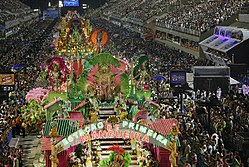Rio Carnival
A samba school is composed of a collaboration of local neighbours that want to attend the carnival together, with some kind of regional, geographical and common background.These are followed by the Mestre-sala and Porta-Bandeira ("Master of Ceremonies and Flag Bearer"), with one to four pairs, one active and three reserve, to lead the dancers, which include the old guard veterans and the "ala das baianas", with the drum line battery at the rear and sometimes a brass section and guitars.Carnival was brought to Brazil by Portuguese colonizers between the 16th and 17th centuries, manifesting itself initially through the 'Entrudo', a popular festival where public games and lighthearted mockery would run wild in the streets.O Moleque by Lima Barreto, depicts an emergence of costume which was originally used in Carnival, tracing back to the European cultural roots.[5] Later in the beginning of the 20th century the Samba and Batucada rhythms classically associated with Rio Carnival were introduced by Afro-Brazilians and Pardos, by adapting different cultural inputs to produce a new musical genre.[7] The pre-existing traditions of the 'Entrudos' and other popular festivities such as the 'ranches' and 'Cordão carnavalesco' that dated from the Empire would eventually be combined into carnival blocks by the 1920s, and evolve into their ultimate form - the Rio samba schools.From 1952 temporary stands for the public were annually assembled, and in 1961 paid tickets made their debut to take advantage of the rising international and national interest and the increasing tourist arrivals.In 1974, due to the works of the subway, the parade was held on Avenida Presidente Antônio Carlos, from where it was also broadcast for the first time in color television.In 1983, the then governor Leonel Brizola commissioned the architect Oscar Niemeyer the project of a permanent local stadium for the parades in that same area, because until then the bleachers had continued to be temporary, and only assembled and disassembled for the event.“Held the week before Ash Wednesday, the samba school parades thrive as both a cultural performance tradition and an urban entertainment business.[citation needed] As the parade is taking place in the Sambadrome and the balls are being held in the Copacabana Palace and beach, many carnival participants are at other locations.Some samba schools have since been motivated by an agenda that focuses on regaining public space, and using the carnival tradition to occupy the streets with parades or blocos.[citation needed] The Queen of the Carnival in Rio de Janeiro and up to two princesses having the duty to woo the revelry, along with the King Momo.



CarnivalBrazilian CarnivalAsh WednesdayPortuguesefestivalsamba schoolsbrass sectionAfro-BraziliansPardosWorld War IWorld War IICOVID-19 pandemic in BrazilMangueiracarnival blocksEstácio de SáPortelaEstação Primeira de MangueiraAvenida Presidente VargasSão JanuárioMarquês de SapucaíLeonel BrizolaOscar NiemeyerFat TuesdayAESCRJSamba é NossoSamba danceCOVID-19 pandemicTiradentes' DaySambadromeDrum QueenLemuel GulliverDragon of Saint Georgecamel caravanstreet blockBanda de IpanemaKing MomoRio de JaneiroOrfeu NegroMarcel CamusOrpheusEurydiceCacá DieguesA MoreninhaJoaquim Manuel de MacedoPaquetá IslandO cortiçoAluísio AzevedoRubem FonsecaSanta Cruz de TenerifeCarnival of Santa Cruz de TenerifeTourism in BrazilCulture of BrazilWayback MachineLibérationLife magazineGrupo EspecialUnidos do ViradouroImperatriz LeopoldinenseAcadêmicos do Grande RioAcadêmicos do SalgueiroUnidos de Vila IsabelBeija-FlorParaíso do TuiutiMocidade Independente de Padre MiguelUnidos da TijucaUnidos de Padre MiguelUnidos do Porto da PedraImpério SerranoSão ClementeUnião da Ilha do GovernadorSérie PrataAcadêmicos da RocinhaSérie BronzeCaprichosos de PilaresGrupo de AvaliaçãoJemberJakartaSinulogAti-Atihan festivalAustriaBincheDenmarkEnglandFinlandGermanyCologneGreeceHungaryVeniceViareggioLithuaniaNetherlandsMadeiraSlavicBelarus, Russia, UkraineCroatiaSloveniaCádizLas PalmasSanta CruzSwitzerlandTurkeyOttawaQuebec CityTorontoMéxicoUnited StatesMobileNew OrleansNew York CityAntiguaBahamasBarbadosCayman IslandsDominicaDominican RepublicTrinidad and TobagoBuenos AiresBrazilSão PauloRecifeColombiaBarranquillaNegros y BlancosFrench GuianaCayenne